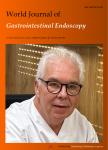Predictor of respiratory disturbances during gastric endoscopic submucosal dissection under deep sedation
作者机构:Department of Frontier SurgeryChiba University Graduate School of MedicineChiba 260-8670Japan Staff of Clinical LaboratorySeirei Sakura Citizen HospitalChiba 285-8765Japan Biostatistics SectionClinical Research CenterChiba University HospitalChiba 260-8677Japan Department of AnesthesiologyChiba University Graduate School of MedicineChiba 260-8670Japan
出 版 物:《World Journal of Gastrointestinal Endoscopy》 (世界胃肠内镜杂志(英文版)(电子版))
年 卷 期:2020年第12卷第10期
页 面:378-387页
学科分类:1002[医学-临床医学] 100214[医学-肿瘤学] 10[医学]
基 金:Supported by Japan Society for the Promotion of Science KAKENHI No.15K09056
主 题:Deep sedation Respiratory depression Polysomnography Endoscopic submucosal dissection Sleep apnea syndrome STOP questionnaire
摘 要:BACKGROUND Sedation is commonly performed for the endoscopic submucosal dissection(ESD)of early gastric *** hypoxemia occasionally occurs due to the respiratory depression during *** To establish predictive models for respiratory depression during sedation for *** Thirty-five adult patients undergoing sedation using propofol and pentazocine for gastric ESDs participated in this prospective observational ***,a portable sleep monitor and STOP questionnaires,which are the established screening tools for sleep apnea syndrome,were *** during sedation was assessed by a standard polysomnography technique including the pulse oximeter,nasal pressure sensor,nasal thermistor sensor,and chest and abdominal respiratory motion *** apnea-hypopnea index(AHI)was obtained using a preoperative portable sleep monitor and polysomnography during ESD.A predictive model for the AHI during sedation was developed using either the preoperative AHI or STOP questionnaire *** All ESDs were completed successfully and without *** patients(49%)had a preoperative AHI greater than 5/*** intraoperative AHI was significantly greater than the preoperative AHI(12.8±7.6 events/h vs 9.35±11.0 events/h,P=0.049).Among the potential predictive variables,age,body mass index,STOP questionnaire score,and preoperative AHI were significantly correlated with AHI during *** linear regression analysis determined either STOP questionnaire score or preoperative AHI as independent predictors for intraoperative AHI≥30/h(area under the curve[AUC]:0.707 and 0.833,respectively)and AHI between 15 and 30/h(AUC:0.761 and 0.778,respectively).CONCLUSION The cost-effective STOP questionnaire shows performance for predicting abnormal breathing during sedation for ESD that was equivalent to that of preoperative portable sleep monitoring.



